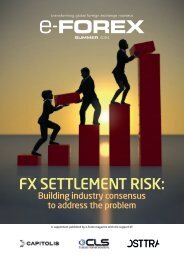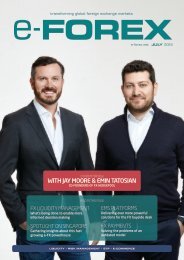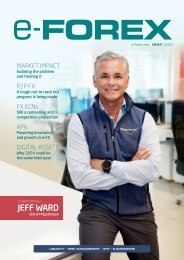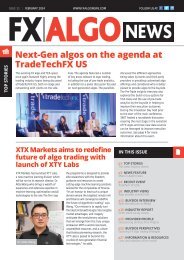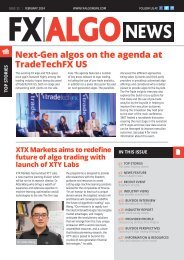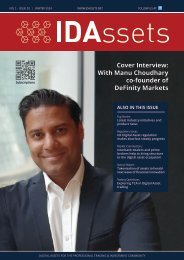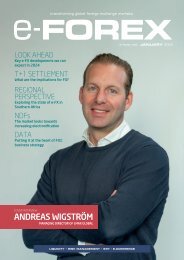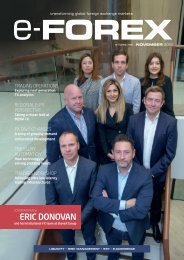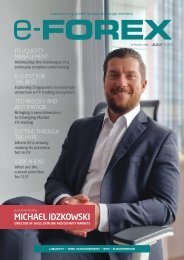You also want an ePaper? Increase the reach of your titles
YUMPU automatically turns print PDFs into web optimized ePapers that Google loves.
Electronification rising amid turbulence: Taking a closer look at the MENA FX picture<br />
REGIONAL E-FX PERSPECTIVE<br />
“During the past couple of years, what with strong GDP<br />
growth in the region, there has been a material shift in FX<br />
requirements, particularly after the pandemic.”<br />
Hussain Almohri<br />
to South Asian countries despite<br />
slowing economic growth (The Gulf<br />
region grew by 7.4% in 2022, a<br />
number expected to drop to 2.5% per<br />
the World Bank.)<br />
“We have seen SAR, AED, and KWD<br />
as the currencies most in demand,”<br />
Almohri says, “with AED having the<br />
most notable growth in terms of<br />
volumes over the past 18 months.”<br />
News is not as positive with the Israeli<br />
Shekel, which has lost strength due<br />
to internal government crises in that<br />
country and the recent war.<br />
Despite Israel’s central bank pouring<br />
$30 billion into supporting its currency,<br />
the Shekel shed 3% in its biggest fall<br />
since February 20<strong>23</strong>, when the judicial<br />
crisis was at its peak. Observers can<br />
divide the MENA picture between<br />
the GCC and the rest, with the rest<br />
experiencing considerable strain.<br />
Lebanon continues to reel under the<br />
weight of consecutive economic crises,<br />
and Egypt’s dependence on external<br />
tourism for hard currency receipts<br />
has not reduced. Given its proximity<br />
to the Gaza war zone and recent<br />
errant excursions by Israel’s military,<br />
Egypt faces significant challenges in<br />
managing its currency exchange rate.<br />
On the positive side, Chinese<br />
investments in the region have<br />
increased, creating more diverse<br />
sources of FX flows, and pushing<br />
traders to call for more transparency<br />
and efficient risk management. Small<br />
vanilla FX flows are largely automated,<br />
with more market participants<br />
demanding TCA as standard.<br />
Albert Blackburn, EMEA EM Business<br />
Development Manager, FX, at LSEG,<br />
explains, “The buy side is eager to<br />
understand trade costs and what their<br />
impact is on the market and how their<br />
liquidity will be used. Pre-trade and<br />
post-trade analytics continue to see an<br />
increase in their usage and offer better<br />
transparency to the market.”<br />
And what about STP and TMS<br />
demands?<br />
“STP and Treasury Management<br />
Systems continue to be rolled out at<br />
pace across the regions as firms seek<br />
to maximise their positions,” he says.<br />
This rise in electronification has shrunk<br />
spreads, with more banks offering<br />
greater context behind their pricing, like<br />
market news and historical trends.<br />
Other transparency-enhancing efforts<br />
include IM communication channels<br />
and data-backed insights into RFQ<br />
workflows. Blackburn lists a few<br />
ways in which LSEG is meeting these<br />
demands. “LSEG FX has a history<br />
of delivering market infrastructure<br />
and workflow tools into frontier and<br />
emerging markets,” he says.<br />
“Matching and FXall offer robust bestin-class<br />
solutions that can be leveraged<br />
by regional banks and clients with<br />
little friction. Our white-label workflow<br />
products provide turn-key solutions<br />
that reduce time-to-market for smaller<br />
banks looking to quickly expand their<br />
digital footprint.”<br />
Regulation and continued government investment in infrastructure are slowly turning the GCC into a hub for<br />
sophisticated investors<br />
Blackburn notes that local banks have<br />
released new features to their platform<br />
in response to corporate demand. And<br />
what are some of these? “Competitive<br />
quotes are always key, and the ability to<br />
trade at the best price is key,” he says.<br />
“However resting orders, options, and<br />
fixing orders are also in demand. Some<br />
of the banks have started to use algo<br />
for trading and this continues to be a<br />
new growth area for the banks that<br />
serve the region.”<br />
34 NOVEMBER 20<strong>23</strong> e-FOREX




